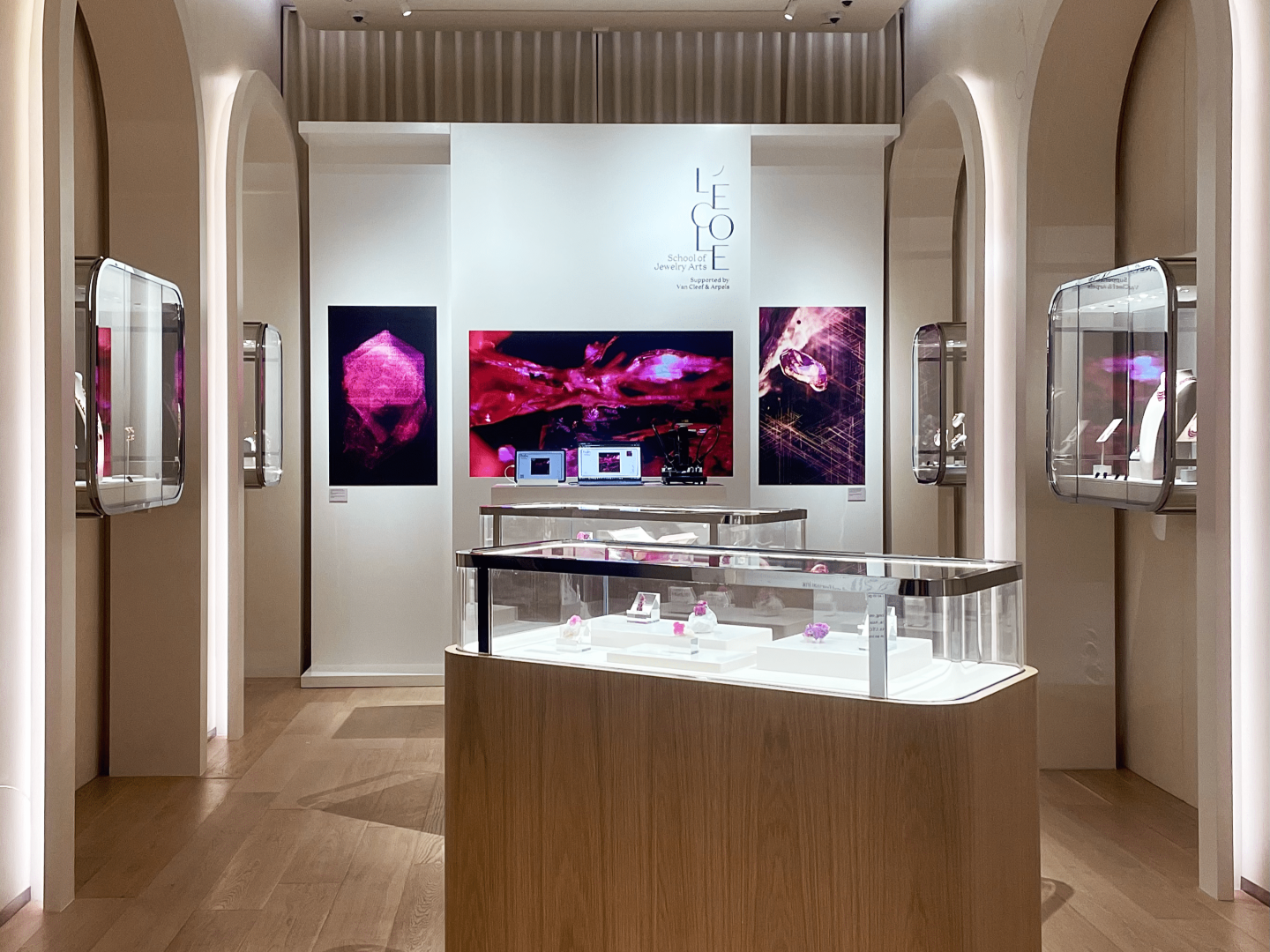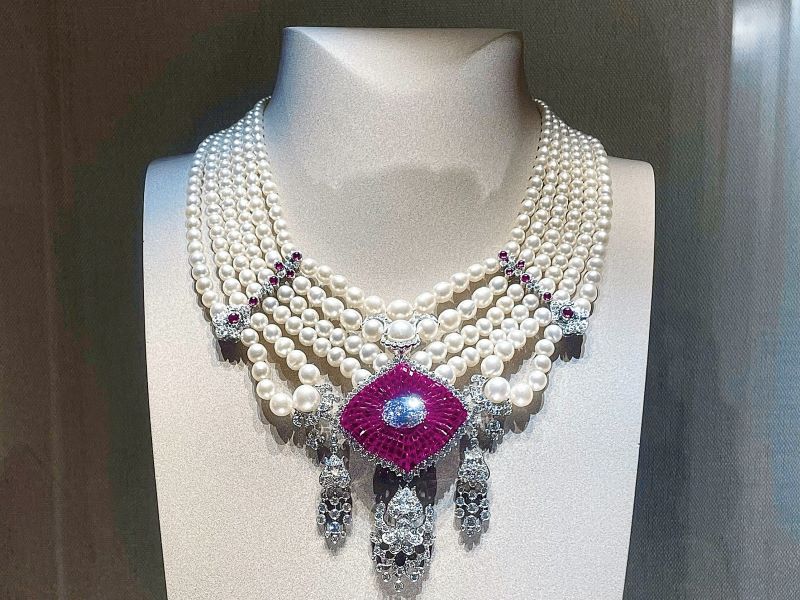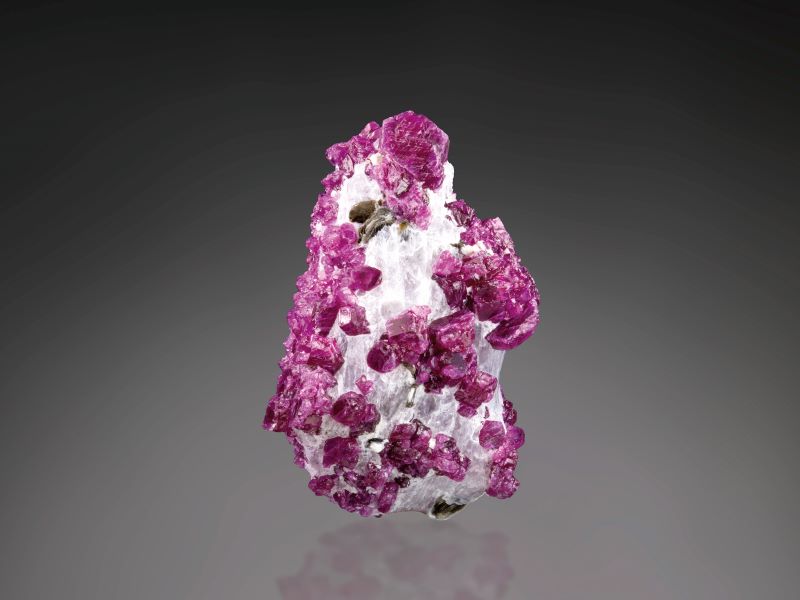
Though small, the exhibition venue holds many enthralling treasures waiting to be discovered (All photos: Van Cleef & Arpels)
There is a Vedic legend that goes something like this. In the midst of a fierce battle, the sun god Surya is injured by the demon king Ravana. As Surya flees, his wounds bleed rubies, which are scattered across the lands of India and the Middle East, where they lie buried in the earth to this day.
Rubies are widely symbolic of love, passion, fury, joy and the continuation of life. In Sanskrit, the stones were referred to as ratnaraj, meaning “king of gems”, and were more valued than any other.
Ancient Hindus believed those who worshipped the god Krishna with the red jewels would be reborn as emperors. In several cultures, rubies were not only representative of the wearer’s wealth and power but were also associated with protection and immortality, making them a cherished possession of monarchs and their armies.
Along with their rarity and durability, the mesmerising red hue affiliated with rubies is a key reason humanity has long been drawn to this stone. Among the most common hues in nature, red is one of the earliest colours found in man-made creations — prehistoric cave paintings featured warm pigments made from hematite; Japanese relics and traditional art forms depict the sun in bright scarlet; and in Christianity, it correlates with charity and the blood of Christ. Red is known to help some flora and fauna attract mates and pollinators, while others use it to ward off predators and as a warning of their deadliness.
Knowing the colour’s appeal, it is no surprise that rubies are one of the most coveted — and expensive — jewels. Adored by gemologists, designers and collectors, they come from the corundum family, a crystallised form of aluminium oxide, and typically bear purplish or orangish hues as well as fascinating inclusions that can be observed under a microscope. Though they have been and remain highly desired, many of the most famous ones known to man, like the 170-carat Black Prince’s Ruby and the engraved Timor Ruby, are actually red spinels, linking back to how rare — and, subsequently, sought after — the real thing is.
img_7982.jpg

Centuries of obsession over rubies has culminated in acclaimed French jeweller Van Cleef & Arpels’ latest exhibition in Singapore, organised in collaboration with L’École, School of Jewelry Arts. Titled Ruby, Discover the Gemstones, the showcase takes over Les Jardins Secrets by Van Cleef & Arpels at Raffles Arcade.
A backdoor in the bijou boutique opens to reveal the exhibition space. Photomicrographic pictures by the father-daughter pair behind Lotus Gemology, Richard W Hughes and Billie Hughes, hang around the room. Each depicts the bizarre and captivating cores of rubies from around the world, from abstract patterns formed by hair-like rutile silk to iridescent film and crystal inclusions.
In the centre of the space, two islands house exceptional rough specimens. Sourced from Pakistan, Afghanistan, Nepal, Myanmar, Vietnam, Macedonia and Tanzania, these raw gems — several still attached to their host stones — may surprise the uninitiated with their vibrant pink and purple tones. The rugged beauty of these samples shine, especially as one learns about their origins and the techniques that go into producing a cut, faceted and polished final stone from the original chunk.
Along the walls, eye-catching jewellery from Van Cleef & Arpels, Lotus Gemology and several other international collectors sit in glass display cases. In one, a transformable necklace crafted in 1990 from yellow and white gold has rubies in polished cabochons surrounded by glittering diamonds. Beside it is a pair of earrings with a similar format, with brilliant round diamonds emanating from the rouge stones like flower petals.
Stripes and contrasting lines appear to be the theme of the next box. A bow-shaped adornment imitates the fluidity of a piece of ribbon. Rows of diamonds and rubies give it a playful peppermint candy look. Loops and curls continue on the neighbouring piece — the rose gold Berunda bracelet sporting alternating bands of diamonds and rubies, the ends of the bangle coiling away from each other like plant vines. Between these two elaborate items, a pair of dainty hoop earrings from the maison’s own collection offers a sense of respite with their simplicity, but are no less glamorous than their display companions.
ruby-specimens-2.jpg

Across the room, a trio of vintage brooches awaits a spectator’s admiration. The sole platinum number demands closer inspection, upon which the eye is rewarded with a glimpse of the six-rayed star effects on the rich magenta focus gems. Moving on, a Hindu-style clip dating back to 1965 is set with an oval cabochon on a diamond-encrusted yellow gold bodhi leaf. The final piece in the trilogy is reminiscent of a floral bouquet, the red jewels like budding blooms peeking out from bedazzled foliage.
Not had your fill of clips just yet? Then the double brooch that can be worn as two separate pieces or together as one large fan-shaped accessory takes the cake. A matching collar necklace intersperses baguette diamonds amidst oval rubies. The stones all bear the same tone, a feat reportedly very difficult to achieve as no two rubies are perfectly alike.
For the finale, the Cadeau Impérial necklace makes sure you complete your viewing on a high note. Constructed in an extravagant bib style, it features rope upon rope of natural white pearls and dangling diamond details. The large focal motif is set with countless tiny rubies, each precisely cut to fit the settings, radiating from the centre diamond.
Before leaving, and in case the wallet does not allow for a small indulgence from the store, you simply have to try your hand at the photomicrography station. A tiny ruby sample is propped under a microscope, and visitors are welcome to adjust the gem’s position and the lens settings to achieve their own unique image of the inner inclusions, which can then be downloaded to their smartphones as a souvenir and a reminder of a ruby’s splendour.
'Ruby, Discover the Gemstones' will run until Oct 20 at Les Jardins Secrets by Van Cleef & Arpels, Raffles Arcade, Singapore. Book your visit at lecolevancleefarpels.com.
This article first appeared on Aug 5, 2024 in The Edge Malaysia.


